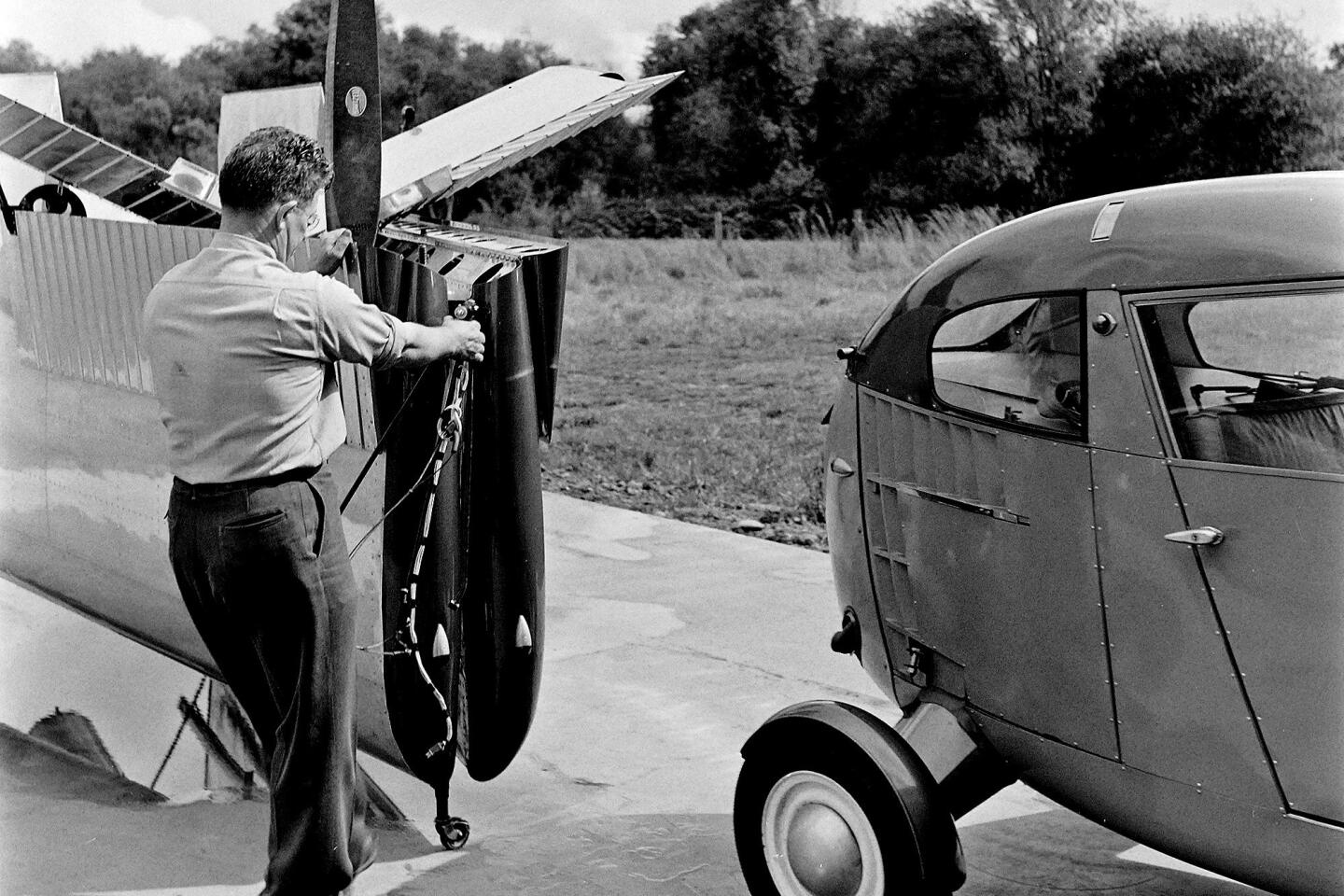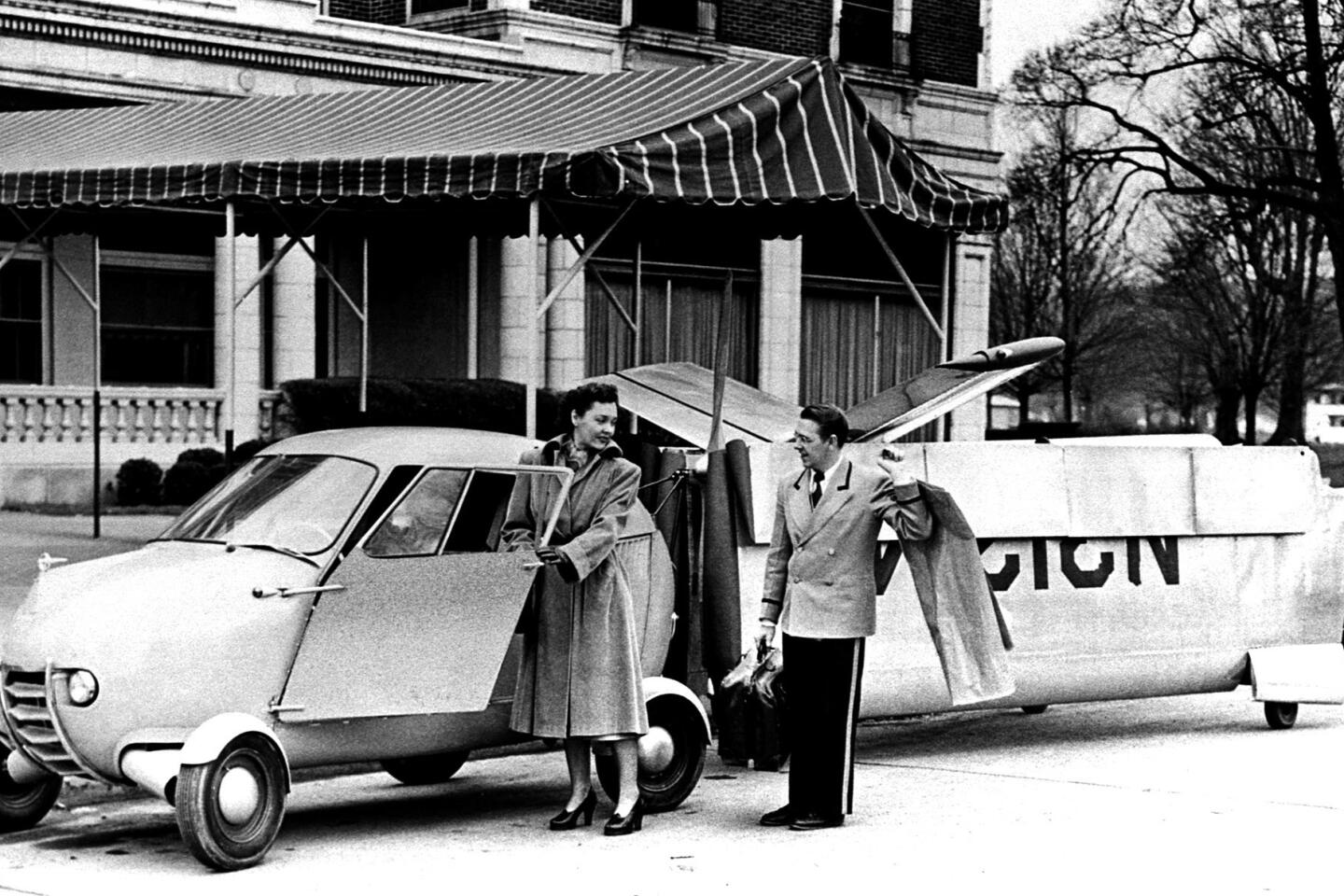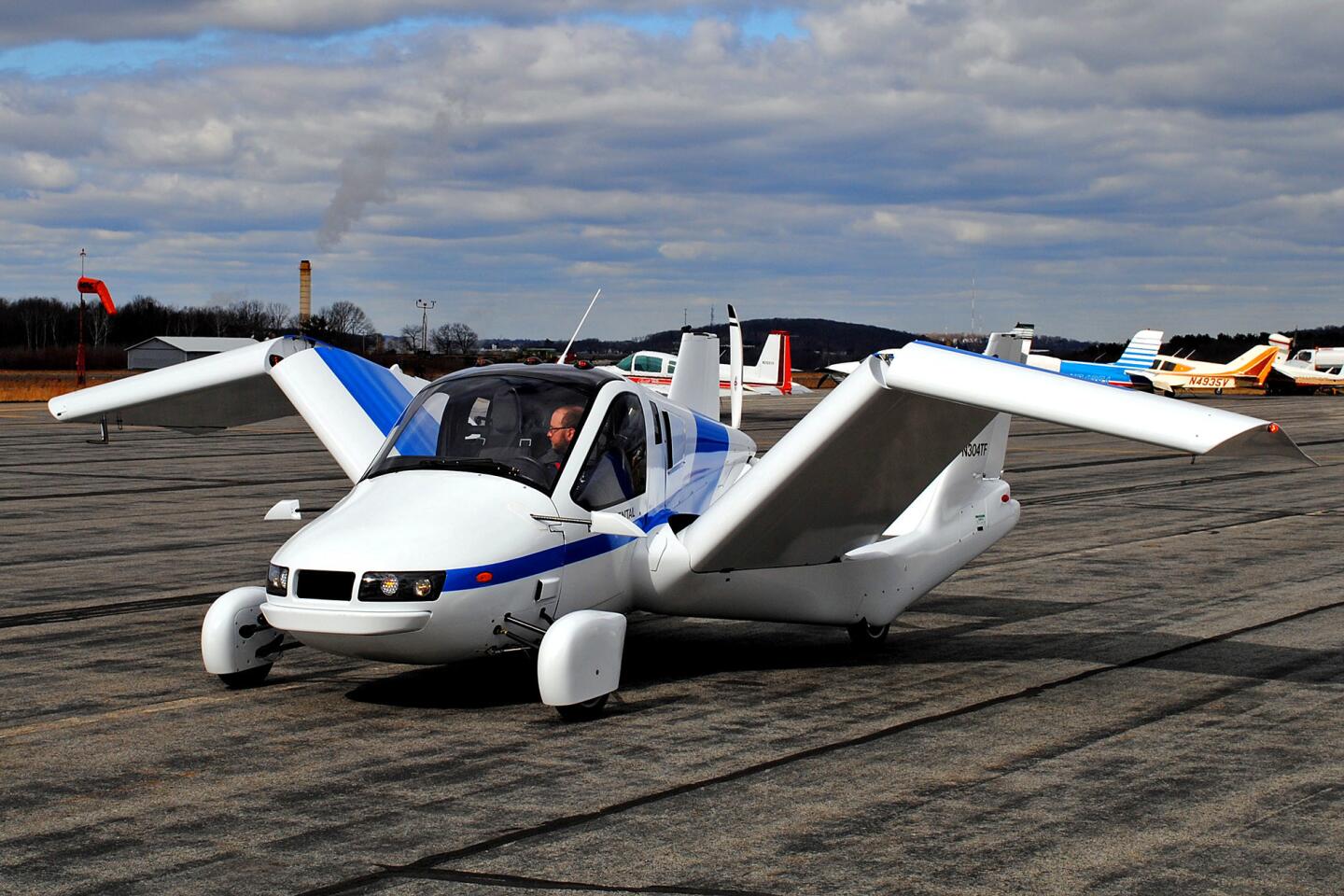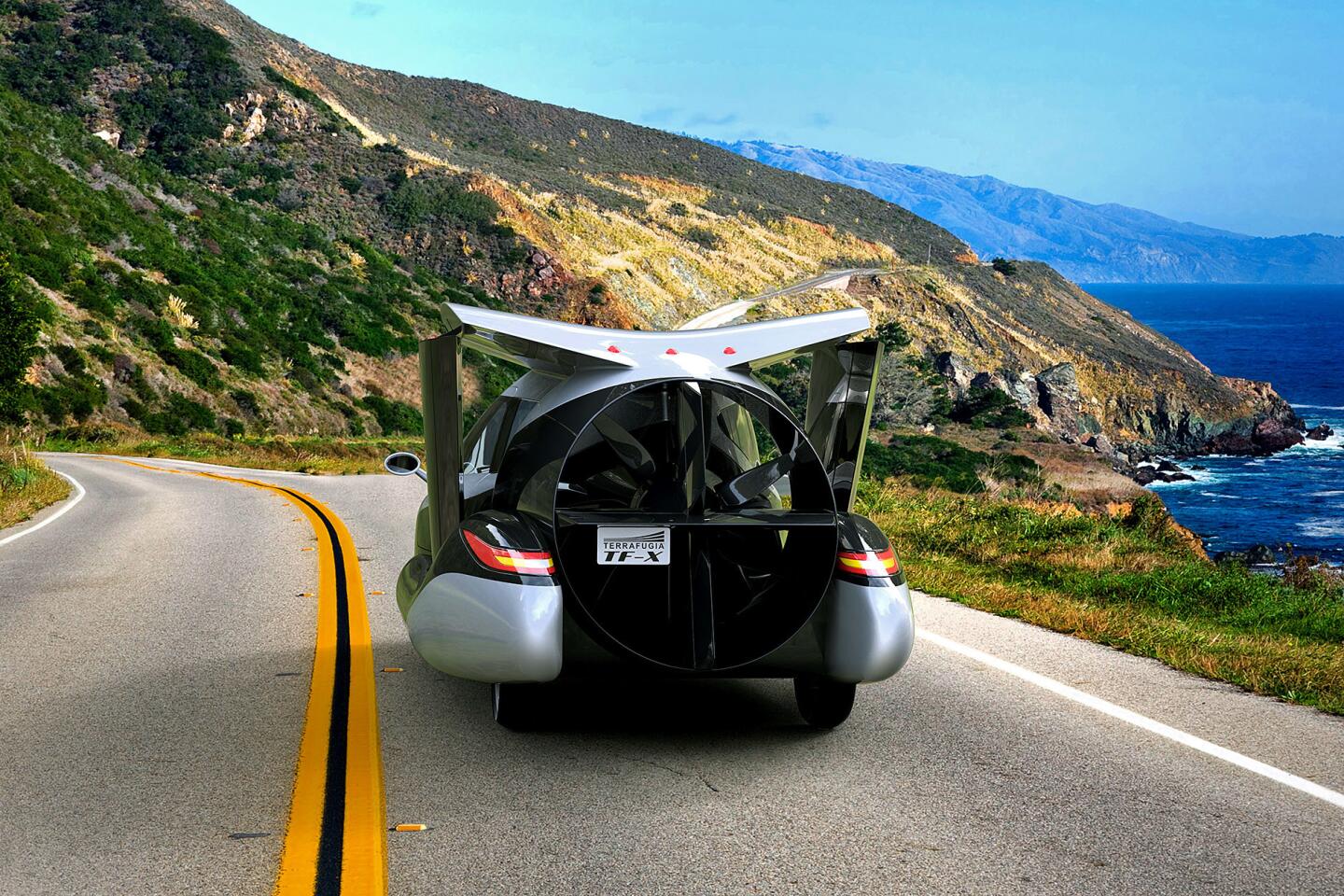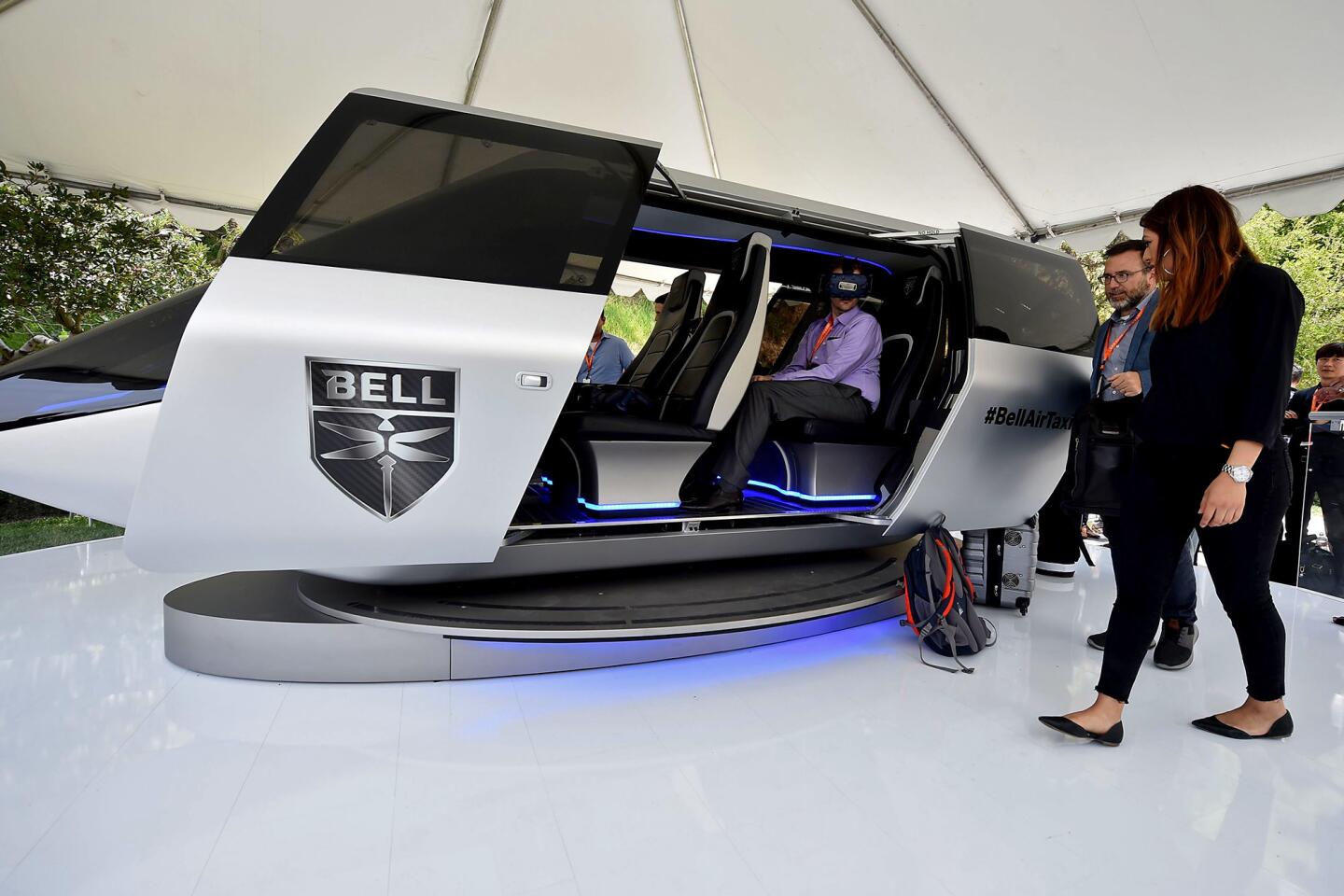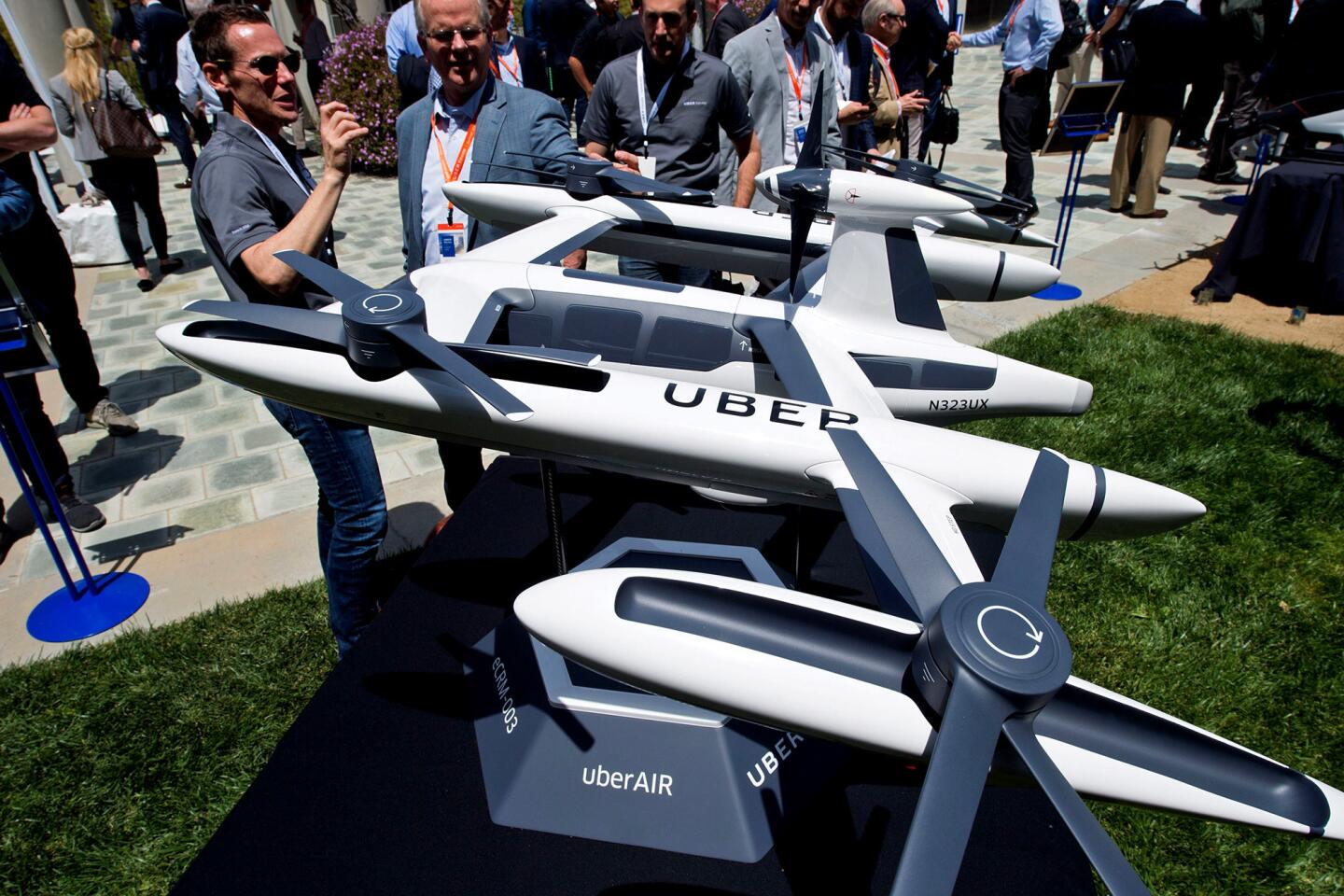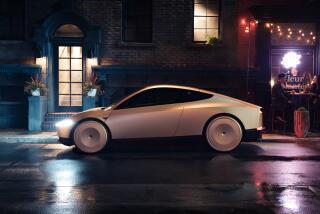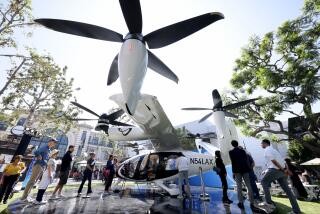A new generation of flying cars is taking to the air. But without the cars
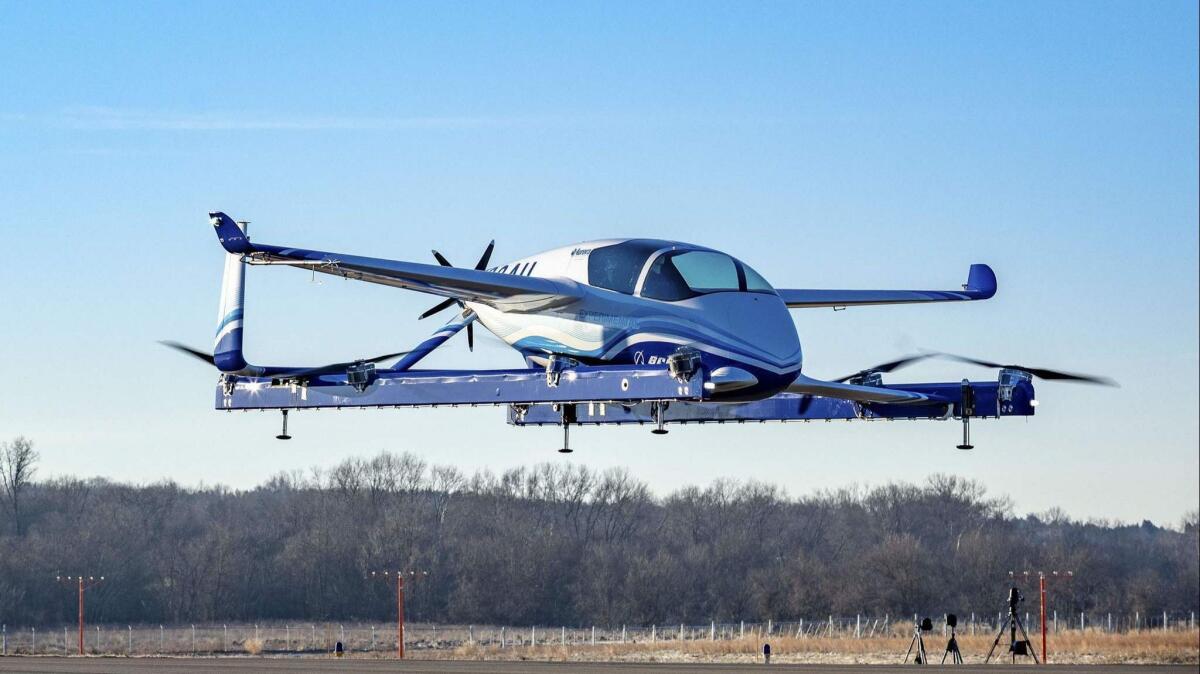
- Share via
For a booming postwar America, spilling out onto vast suburban tracts and enthralled with the possibilities of new technology, the flying car was an intriguing chimera.
Attach the wings and propeller of a plane to the body of a car and drivers might pull out of their garage, motor to an open area and take off, leaving long commute times far below.
In time, of course, the flying car became a catchphrase for a future that never arrived. But could its time finally be at hand?
No fewer than 70 companies are designing, building and testing this era’s version of the flying car. Just don’t expect much “car.” Thanks to advances in electric propulsion technology, the new designs look more like many-rotored helicopters. And while the early concepts were envisioned as personal transportation, the reality is more likely to be short-range flying taxi services in cities.
Uber Technologies Inc. has a division focused on aviation, including a proposed aerial ride-hailing option called Uber Air. The San Francisco firm has teamed up with several flying car manufacturers to build the vehicles for its service, and plans to test them in Los Angeles and Dallas in 2020.
Last month, aerospace giant Boeing Co. conducted the first test flight of its autonomous flying car prototype. Just a year ago, the company said, it had only a conceptual design.
While some companies still plan to offer cars for purchase to deep-pocketed individuals, many, like Bell Helicopter Textron Inc., are banding around an urban ride-hailing model for the skies, in which everyday customers would gather at a helipad and board a shared aircraft.
The emergence of short-hop commuter air vehicles could change the way cities look. Shorter commute times may lead to greater urban sprawl, but might also open up new employment opportunities, industry experts say.
“Air taxis could help connect people and jobs in ways that aren’t viable via today’s existing roadway or transit network,” said Laurie Garrow, associate director for the Center for Urban and Regional Air Mobility at Georgia Tech. “What may take an hour and a half to get between two locations today may take 20 minutes in the future.”
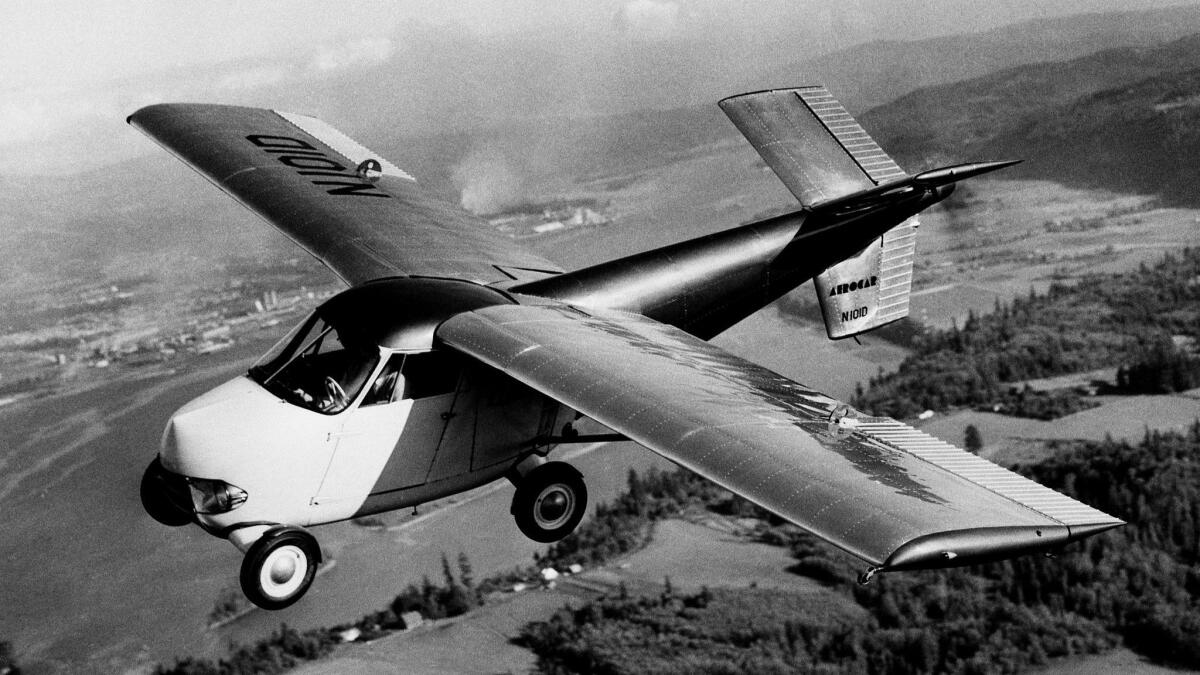
There are still many technological and regulatory barriers to clear before these vehicles can take flight. Rules will be needed on such things as flying above congested urban areas and noise levels. Some industry officials believe a recent Federal Aviation Administration rewrite of laws governing small aircraft certification standards is a step toward giving companies more leeway in deciding how they’ll meet safety guidelines rather than dictating specifically how it should be done.
The challenge for early inventors was to square the conflicting imperatives of each transportation mode, said Jake Schultz, author of “A Drive in the Clouds: The Story of the Aerocar” and a corporate historian for Boeing. Planes are typically lightweight, which can make them delicate to drive on the road. A car needs safety features such as bumpers and heavy windshields, which can add heft. “Weight is the enemy of aviation,” Schultz said.
The first functional flying car is thought to be the aluminum-bodied Autoplane made by aviation pioneer Glenn Curtiss. The vehicle was completed in late 1916 or early 1917 and took some short-hop flights, though further testing and production plans were scrapped due to World War I. In 1949, designer Moulton “Molt” Taylor completed a prototype and later, four production Aerocars, which had wings and a tail that could fold into a trailer.
Taylor also considered building a vehicle with a car body and a rotary wing to provide vertical lift, similar to a helicopter or autogyro. He chose to focus on the aircraft version, but the vertical-lift design was feasible.
Vertical lift is a key feature in today’s flying car concepts.
Industry experts say the electric-powered vertical takeoff and landing (eVTOL) aircraft currently under development by Boeing, Embraer and Airbus will only require a helipad rather than a runway in cities, where space is at a premium. They could also be quieter, safer and eventually more cost-effective than gas-powered helicopters.
The vehicles use distributed electric propulsion, which means multiple, separate generators and rotors. That provides redundancy in case of a malfunction, said Pat Anderson, director of the Eagle Flight Research Center at Embry-Riddle Aeronautical University. As an additional safety feature, some vehicles, such as the Transition personal flying car by Terrafugia, a Woburn, Mass., flying car company, will also have a parachute system.
Advances in battery and electric-motor technology gleaned from the auto industry, as well as improvements in lightweight carbon-fiber materials, are another reason eVTOL flying car designs are more viable than they may have been 10 years ago, said Chuck Evans, vice president of marketing, communications and business development at Terrafugia.
“The aeronautics industry has advanced significantly since the ‘Jetsons’ cartoon,” said Richard Wallace, vice president of transportation systems analysis at the Center for Automotive Research think tank in Ann Arbor, Mich. “And they’re taking advantage of what’s been learned.”
Boeing ran its autonomous passenger air vehicle prototype through takeoff, hover and landing maneuvers last month. The vehicle has a range of 50 miles, and future craft could come in two- and four-passenger versions.
“Traffic in dense, urban areas is going to quickly go from two dimensions to three dimensions,” Boeing Chief Executive Dennis Muilenburg said during last month’s World Economic Forum in Davos, Switzerland.
Uber has partnered with aircraft manufacturers Boeing, Embraer and Bell to work on its proposed Uber Air offering. Customers would go to a “vertiport,” where they could board an electric flying car, fly 1,000 to 2,000 feet up in the air for a short distance, then connect to ground transportation.
The ride-hailing company says it is working with federal regulators, local stakeholders and city transportation departments and plans to start commercial operations in Dallas, L.A. and a third, yet-unnamed international city by 2023. Uber has said the price per flight could eventually be comparable to an UberX car ride.
“We are essentially in a whole Wright brothers era,” said Nikhil Goel, head of product at Uber Elevate, the aerial division. “Doing it safely is so important. We want to do it with the right stakeholders from Day One.”
Uber, Terrafugia and others plan to have human pilots at the helm, at least initially, before eventually transitioning to fully autonomous flying vehicles. The early Uber Air pilots will probably be commercially rated helicopter pilots, though the company is working with the FAA to determine the appropriate future requirements for pilots, assuming that the flying cars’ technology could make them easier to fly, Goel said. Those pilots will probably be employed by the fleet operators, rather than Uber itself, he said.
Acceptance of airborne autonomy could be influenced by its progress in road vehicles, which has advanced more slowly than some proponents expected.
A report released last December by Morgan Stanley notes that strides made in autonomous car-sharing networks could be an “incubator and accelerator for the framework of regulation and consumer acceptance of flying car tech.” But if autonomous cars are not embraced by the public — an autonomous Uber car killed a pedestrian last year, and Waymo test vehicles have been attacked several times — autonomous flying cars are “going to have a tough road,” said Anderson of Embry-Riddle.
A Booz Allen Hamilton study on the urban air mobility market released in October found that an air taxi market could serve about 80,000 passengers per day across the U.S., with about 4,000 aircraft. The annual value of that market was projected at about $2.5 billion for the first few years of operation.
The recent evolution of flying cars from a personal gadget to a service can be seen in the changing plans of one company.
About three years after Terrafugia was founded in 2006, it unveiled the Transition personal flying car. That vehicle, which is still under development today and is largely targeted toward pilots, has a gas engine and requires a runway to take off and land. A prototype combined the control systems of an airplane with that of a car — an unfoldable stick, throttle and rudder pedals alongside a steering wheel and gas and brake pedals, according to a video posted by the company in 2009. Evans, the marketing executive, said Terrafugia hasn’t named a specific price, but it could cost more than $200,000. Just a handful of customers have put down deposits, he said.
But last year, Terrafugia — which was purchased by Volvo owner Zhejiang Geely Holding Group in 2017 — unveiled a new system, the TF-2, which utilizes a van-like vehicle and a passenger pod intended to transfer seamlessly from the ground vehicle to an eVTOL aircraft, using centralized locations. Upon arrival, that pod would be picked up by another van, which would take passengers to their final destination. The company has not yet released a date for when the TF-2 will be available.
“We think the volume is going to be on the rideshare” market, Evans said. “Back in 2006, when our founders started the company, I don’t think eVTOL was quite capable. There’s a lot of value in what we have learned … and we have that experience under our belts now.”
Schultz, the author, sees similarities between the work being done now and the earlier era of flying car development.
“Right after World War II ended, there was a huge aspect of, ‘anything is possible now,’” he said. “That was the kind of wave of enthusiasm that Molt Taylor was riding on. Now, I think there’s … a renewed sense of anything’s possible.”
Twitter: @smasunaga
More to Read
Inside the business of entertainment
The Wide Shot brings you news, analysis and insights on everything from streaming wars to production — and what it all means for the future.
You may occasionally receive promotional content from the Los Angeles Times.
